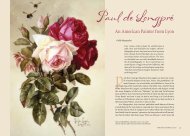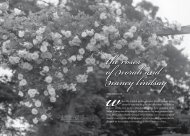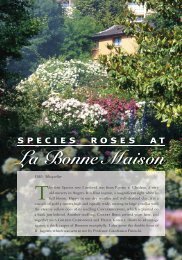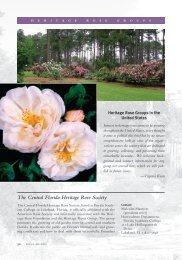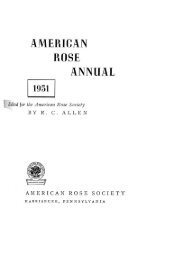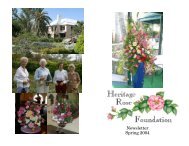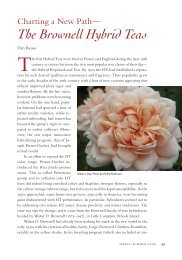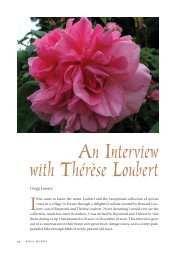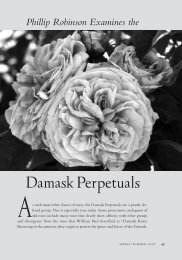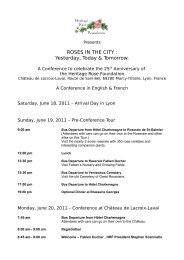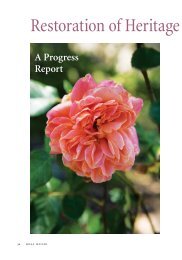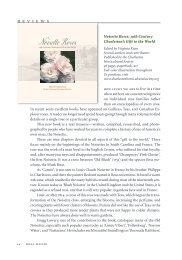Newsletter - Heritage Rose Foundation
Newsletter - Heritage Rose Foundation
Newsletter - Heritage Rose Foundation
You also want an ePaper? Increase the reach of your titles
YUMPU automatically turns print PDFs into web optimized ePapers that Google loves.
In This Issue:<br />
Letter from HRF President<br />
Stephen Scanniello p. 1<br />
Note from Anita Clevenger on the Sacramento<br />
Conference p. 4<br />
Note from Cydney Wade on the Sacramento<br />
Conference p. 5<br />
New DVD Available p. 6<br />
<strong>Rose</strong>Dango Moving to Spring, by Claude<br />
Graves p. 6<br />
Book Review, by Maureen Detweiler p. 7<br />
Article: The Climbing Prairie <strong>Rose</strong> — Rosa<br />
setigera, by Gregg Lowery p. 9<br />
Note on The <strong>Rose</strong> Collection at Florida<br />
Southern College, by Malcolm Manners p. 16<br />
From the Editor p. 16<br />
Upcoming Events p. 17<br />
Contact addresses p. 19<br />
Illustration of the<br />
rose 'Rosa Mundi' by<br />
James Sagmiller. This<br />
artwork was used on<br />
the front cover of the<br />
first issue of Rosa<br />
Mundi, the journal of<br />
the HRF, in Autumn,<br />
2005.<br />
HRF Mission and Goals p. 19<br />
List of Trustees, Officers, and Advisors p. 19<br />
<strong>Heritage</strong> <strong>Rose</strong> <strong>Foundation</strong><br />
<strong>Newsletter</strong><br />
December, 2012<br />
Letter from HRF President<br />
Stephen Scanniello<br />
I’m sure that many of you are<br />
wondering what’s been going on with the<br />
<strong>Heritage</strong> <strong>Rose</strong> <strong>Foundation</strong>. It’s been over a<br />
year since Rosa Mundi was published and<br />
even longer since you’ve received a<br />
newsletter. No, we haven’t disbanded. No,<br />
we haven’t succumbed to Knock Out.<br />
We’re still here, and rose preservation is<br />
still our mission. But, before I explain what<br />
we’ve been up to, on behalf of the Board of<br />
Trustees of the <strong>Heritage</strong> <strong>Rose</strong> <strong>Foundation</strong>,<br />
and as president, I would like to apologize<br />
to all of you for our recent lack of<br />
communication.<br />
We are in the process of resurrecting<br />
Rosa Mundi, upgrading our web page and<br />
Facebook page. If you are reading this,<br />
then you are experiencing our first<br />
electronic newsletter. Yes, the <strong>Heritage</strong><br />
<strong>Rose</strong> <strong>Foundation</strong> is finally moving into the<br />
21 st Century to further our cause to save<br />
and protect our heritage roses from<br />
centuries past.<br />
Here’s a review of some of our projects<br />
from the past year:<br />
Historic <strong>Rose</strong> Symposium,<br />
Sacramento, CA:<br />
Sacramento was the site for our most<br />
recent membership meeting and<br />
symposium celebrating the 20 th<br />
anniversary of the Historic <strong>Rose</strong> Garden of<br />
Sacramento, the name for the beautiful<br />
rose collection housed within the borders
<strong>Heritage</strong> <strong>Rose</strong> <strong>Foundation</strong> <strong>Newsletter</strong>, December 2012 Page 2<br />
_______________________________________________________________________________<br />
of the Historic City Cemetery of<br />
for the District. The New York Chapter of<br />
Sacramento. This event was a joint effort the Garden Club of America awarded the<br />
between the Old City Cemetery<br />
<strong>Heritage</strong> <strong>Rose</strong> <strong>Foundation</strong> a grant of $2500<br />
Committee, the <strong>Heritage</strong> <strong>Rose</strong>s Group, and to be used for the <strong>Heritage</strong> <strong>Rose</strong> District.<br />
the <strong>Heritage</strong> <strong>Rose</strong> <strong>Foundation</strong>. I’m very Recently, the New York Genome Center<br />
proud to say that many members of the has approached us to discuss a possibility<br />
<strong>Heritage</strong> <strong>Rose</strong> <strong>Foundation</strong> serve as<br />
of conducting detailed genetic studies of<br />
volunteers in the Historic <strong>Rose</strong> Garden. old garden roses.<br />
[See Anita Clevenger's and Cydney Wade's<br />
notes on the event, later in this letter.]<br />
The High School for<br />
Environmental Studies, NYC:<br />
Located in Hell’s Kitchen, a Manhattan<br />
neighborhood south of Harlem, this high<br />
school is part of the New York City public<br />
school system and was recently rated one<br />
of ten top high schools in NYC. This past<br />
year, the HSES partnered with the<br />
<strong>Heritage</strong> <strong>Rose</strong> District. With the assistance<br />
of students from Florida Southern College,<br />
their rooftop garden has been transformed<br />
into a garden for heritage roses, creating a<br />
living laboratory for the high school and<br />
providing ample opportunities to study<br />
old roses. Currently, several students in<br />
the Advanced Placement (AP) Biology<br />
classes are conducting genetic studies on<br />
various roses. Propagation techniques will<br />
also be studied, and eventually this could<br />
serve as a local nursery for the District.<br />
We’re hopeful that the students will share<br />
their work with us at our Florida meeting<br />
in November.<br />
The <strong>Heritage</strong> <strong>Rose</strong> District of<br />
New York City:<br />
The <strong>Heritage</strong> <strong>Rose</strong> District continues to<br />
grow and serve as a major preservation<br />
effort as well as a beacon for the HRF in<br />
New York City and beyond. This project, a<br />
collaboration between the <strong>Heritage</strong> <strong>Rose</strong><br />
<strong>Foundation</strong> and the Office of the Borough<br />
President of Manhattan, continues to<br />
introduce new generations of city<br />
gardeners to old roses and bring awareness<br />
to the cause of rose preservation. In an era<br />
when old roses are being de-accessioned<br />
from public gardens, the <strong>Heritage</strong> <strong>Rose</strong><br />
<strong>Foundation</strong> has created “safe” collections<br />
of heritage roses in more than thirty-five<br />
sites throughout the New York City<br />
neighborhood of Harlem. As of November<br />
2012, over 1000 heritage roses have been<br />
planted and are tended to by enthusiastic<br />
volunteer gardeners of all ages — from<br />
five-year-old girl scouts to senior citizens.<br />
Recent additions to the District project<br />
include the Schomburg Center for<br />
Research in Black Culture, Morningside<br />
Park, Hamilton’s Grange National<br />
Memorial, and the High School for<br />
Environmental Studies. This past spring,<br />
students from Florida Southern College<br />
conducted a propagation workshop for<br />
young gardeners from the Dorothy Day<br />
Apartments. On June 9, Borough President<br />
Scott Stringer presented Dallas high school<br />
senior Jacob Graff a proclamation in honor<br />
of his work for creating a walking tour app<br />
Chambersville <strong>Heritage</strong> <strong>Rose</strong> Garden,<br />
Chambersville TX:<br />
This garden continues to grow in size<br />
and popularity. In over 12 acres of land<br />
north of Dallas, the HRF has worked<br />
closely with nurseryman Dean Oswald to<br />
gather the largest collection of heritage<br />
roses that are suitable for this region of the<br />
country. During the fifth annual festival,<br />
<strong>Rose</strong>Dango, it was announced that the next<br />
addition to this garden would be The Anne<br />
Belovich Rambler Garden, a collection of<br />
rambling and climbing roses from the
<strong>Heritage</strong> <strong>Rose</strong> <strong>Foundation</strong> <strong>Newsletter</strong>, December 2012 Page 3<br />
_______________________________________________________________________________<br />
Washington garden of HRF member Anne roses and companion plants for attracting<br />
Belovich. The roses are currently being<br />
birds, bees, and butterflies to the garden.<br />
propagated by the students at Florida<br />
The native plants have been generously<br />
Southern College. The garden will contain donated by Dr. Bud Willis, owner of Willis<br />
a total of approximately 200 ramblers, 56 of Farm in Doyline , Louisiana. This project<br />
which have already been sent to<br />
has transformed the former Hudson<br />
Chambersville for growing out. Planting <strong>Heritage</strong> Garden into an oasis of beauty.<br />
will begin during the winter of 2013. To Not without challenges, we continue to<br />
showcase these beautiful spring blossoms, donate our sweat equity to this project. The<br />
the <strong>Rose</strong>Dango festival has been moved next major event in this garden will be the<br />
from autumn to spring. The 2013 event annual pruning party in February 2013, the<br />
will be held Sunday, April 28, and the<br />
exact date to be announced.<br />
Belovich garden will be dedicated on May<br />
4, 2014. [See Claude Graves' note about<br />
Farmers Branch, TX:<br />
this event, below.]<br />
Under the guidance of Farmers Branch<br />
horticulturist and HRF Board member Pam<br />
Smith, the public rose collections in<br />
Farmers Branch have grown to rival any<br />
major public rose garden worldwide.<br />
<strong>Heritage</strong> roses are an important part of this<br />
collection. During the last year, over 500<br />
heritage roses (donated by the Antique<br />
<strong>Rose</strong> Emporium) were distributed to<br />
young gardeners through public programs<br />
organized by Farmers Branch and the<br />
<strong>Heritage</strong> <strong>Rose</strong> <strong>Foundation</strong>.<br />
Anne Belovich<br />
<strong>Heritage</strong> Habitat Garden in the American<br />
<strong>Rose</strong> Center, Shreveport, LA:<br />
Several HRF members continue to<br />
volunteer at the American <strong>Rose</strong> Center to<br />
help maintain the newly christened<br />
<strong>Heritage</strong> Habitat Garden – a garden of<br />
heritage roses, shrubs, perennials, trees,<br />
and bulbs. A majority of the plants chosen<br />
are native to the northern Louisiana<br />
region. The goal of this garden is to show<br />
the home gardener how to use old garden<br />
Wyck House and Gardens, Philadelphia<br />
The topic of the 2012 Wyck Old <strong>Rose</strong><br />
Symposium on May 19 th was “Fragrance<br />
and Old <strong>Rose</strong>s." This was the third<br />
collaboration between Wyck, the <strong>Heritage</strong><br />
<strong>Rose</strong> <strong>Foundation</strong>, and the American <strong>Rose</strong><br />
Society. Wyck, Philadelphia’s oldest house<br />
and garden, is where Léonie Bell, one of<br />
the charter members of the <strong>Heritage</strong> <strong>Rose</strong>s<br />
Group, conducted much of her research.<br />
The <strong>Heritage</strong> <strong>Rose</strong> <strong>Foundation</strong> will once<br />
again join forces with two ARS affiliates,<br />
the Philadelphia and West Jersey <strong>Rose</strong><br />
Societies, for the 2013 conference to be held<br />
on May 18.<br />
So, as you can see, even though we<br />
haven’t met our expectations with<br />
publications, we are still very active in the
<strong>Heritage</strong> <strong>Rose</strong> <strong>Foundation</strong> <strong>Newsletter</strong>, December 2012 Page 4<br />
_______________________________________________________________________________<br />
preservation of old roses. We would like to garden was first planted in the Sacramento<br />
hear of your activities and include them in Historic City Cemetery in March, 1992,<br />
future editions of the HRF <strong>Newsletter</strong>.<br />
with about 100 roses collected by botanist<br />
And, if you have some spare time on your Fred Boutin and others from historic<br />
hands, you're always welcome to<br />
cemeteries, homes and roadsides<br />
volunteer with any of our projects.<br />
throughout California. The collection has<br />
In this time when all you see in local expanded to over 500 heritage and species<br />
nurseries are "easy care" modern roses, we roses, including many roses that have been<br />
need to continue educating amateur and lost from their original site but live on in<br />
professional gardeners that heritage roses the cemetery garden.<br />
supply the key genetic ingredients<br />
The weekend focused on the cemetery,<br />
necessary to create tomorrow's new<br />
its rose garden, the people who collect,<br />
disease-resistant and fragrant varieties. It's study and grow its roses, and the roses<br />
important to remind all — without old<br />
themselves. Time was built into the<br />
garden roses, new varieties like Knock<br />
schedule for the 91 people in attendance to<br />
Out may never have happened. Our goal relax and mingle. Friday night's reception<br />
is to insure the preservation of these old included a Lantern Tour, with costumed<br />
beauties for future generations of<br />
actors recounting eerie tales of historic<br />
gardeners.<br />
figures buried in the cemetery. Saturday<br />
As old rose nurseries continue to<br />
morning's talks looked back on the early<br />
close and rose society memberships<br />
days of the cemetery and the rose garden,<br />
continue to shrink, I’m thankful that the California rose history and Santa Barbara's<br />
membership of the <strong>Heritage</strong> <strong>Rose</strong><br />
Father Schoener, most of whose roses have<br />
<strong>Foundation</strong> has remained stable. I wish to been lost. In the afternoon the focus<br />
thank all devoted members who have<br />
shifted to found roses, including Fred's<br />
stuck with us during this past year and recent discovery of a rose that may be<br />
especially to all who have been with us 'Bloomfield Abundance', a rose long<br />
since we began in 1986. To all those<br />
thought to be extinct. At dinner, Stephen<br />
members whose memberships have lapsed Scanniello continued this optimistic note<br />
— come on back, we miss you!<br />
by telling about the gardens being<br />
Thank you for your continued support established in New York's <strong>Heritage</strong> <strong>Rose</strong><br />
of the <strong>Heritage</strong> <strong>Rose</strong> <strong>Foundation</strong>.<br />
District and elsewhere, introducing a new<br />
generation to heritage roses. On Sunday,<br />
many attendees returned to the cemetery<br />
to tour the garden and enjoy the beautiful<br />
cemetery grounds.<br />
The conference was sponsored by the<br />
<strong>Heritage</strong> <strong>Rose</strong> <strong>Foundation</strong>, the <strong>Heritage</strong><br />
<strong>Rose</strong>s Group, and the Old City Cemetery<br />
A Note From Anita Clevenger, on<br />
Committee. American <strong>Rose</strong> Society<br />
members and leaders were also in<br />
the Sacramento Conference<br />
attendance. The goal of the conference was<br />
The volunteers of the Sacramento<br />
to draw everybody together, united in the<br />
Historic <strong>Rose</strong> Garden hosted a conference love of old roses and the Sacramento<br />
celebrating twenty years of rose<br />
preservation on Oct 12-14, 2012. The<br />
Historic <strong>Rose</strong> Garden.
<strong>Heritage</strong> <strong>Rose</strong> <strong>Foundation</strong> <strong>Newsletter</strong>, December 2012 Page 5<br />
_______________________________________________________________________________<br />
A Note on the<br />
Sacramento Conference<br />
From Cydney Wade<br />
Archer, Florida<br />
The 20th Anniversary of the <strong>Heritage</strong><br />
<strong>Rose</strong> Symposium in Sacramento, California<br />
was a must-see event. A huge thanks to all<br />
of the folks who worked so hard to make<br />
the event such a success!<br />
Each part of the three day symposium<br />
was impressive. Beginning with Friday<br />
The big rose sale in Sacramento -- always a<br />
evening in the Historic City Cemetery,<br />
highlight of a rose conference!<br />
members in period dress welcomed the<br />
attendees, offering wine and a nice<br />
selection of light fare. After dark, lanternlit<br />
walking tours were hosted complete<br />
with actors representing some of the<br />
cemetery "residents" who told stories about<br />
events in old Sacramento.<br />
Saturday was a full day of events,<br />
from presentations covering a wide array<br />
of topics to spirited bidding especially for<br />
some of the found roses now growing in<br />
the Historic City Cemetery. The evening<br />
was complete with an evening meal and<br />
presentation from Stephen Scanniello,<br />
president of the <strong>Heritage</strong> <strong>Rose</strong> <strong>Foundation</strong>.<br />
On Sunday, guided tours of the rose<br />
garden provided background and stories<br />
of many of the roses growing in this threeacre<br />
section of the cemetery. It was so<br />
impressive seeing all of the different roses<br />
and hearing the details about the process<br />
the group uses to collect, mark, identify<br />
and care for this very special collection of<br />
heritage roses.<br />
Cemetery volunteers in costume for the Friday<br />
evening event. Front row l-r: Judy Eitzen, Barbara<br />
Oliva, Anita Clevenger. Back row l-r: Patricia<br />
Hutchings, Patricia Schink, and Kathryn Mackenzie
<strong>Heritage</strong> <strong>Rose</strong> <strong>Foundation</strong> <strong>Newsletter</strong>, December 2012 Page 6<br />
_______________________________________________________________________________<br />
Garden in North Texas, is moving to a<br />
spring date! At the October 2012<br />
<strong>Rose</strong>Dango it was announced that<br />
Chambersville will be building and<br />
planting a new garden featuring a<br />
duplication of Anne Belovich’s fantastic<br />
collection of rambling roses. In recognition<br />
of the realities of a large collection of once<br />
blooming ramblers, Chambersville has<br />
elected to move the traditional October<br />
date of <strong>Rose</strong>Dango to the spring so all the<br />
HRF President Stephen Scanniello and<br />
Chambersville <strong>Heritage</strong> <strong>Rose</strong> Garden’s<br />
Barbara Oliva, in the Sacramento<br />
Historic <strong>Rose</strong> Garden<br />
collections — Teas, Chinas, Hybrid Musks,<br />
and Ramblers — can all be observed while<br />
New DVD Available<br />
in bloom.<br />
Anne Belovich, who was the featured<br />
speaker at the 2012 <strong>Rose</strong>Dango, has<br />
already been sending cuttings for the new<br />
rambler garden to Malcolm Manners in<br />
Florida to be rooted. The first group of<br />
rooted cuttings have been shipped to<br />
Chambersville and after overwintering in<br />
cold frames will be grown out to be<br />
planted next summer/fall in the new<br />
garden, which is being designed by<br />
Stephen Scanniello.<br />
The dedication of the Anne Belovich<br />
Rambler Garden is scheduled for May 4,<br />
2014; in the meantime the 2013 <strong>Rose</strong>Dango<br />
has been scheduled for April 28, 2013 to<br />
establish the season switch for the event<br />
and prepare for the 2014 Anne Belovich<br />
A new DVD celebrating the Sacramento Rambler Garden dedication.<br />
Historic <strong>Rose</strong> Garden was introduced at<br />
the Sacramento Conference. It traces the<br />
history of the garden and includes<br />
beautiful videography of the garden and<br />
its roses. Copies of the DVD are available<br />
for $20, including shipping, through their<br />
website www.cemeteryrose.org<br />
<strong>Rose</strong>Dango Moving to the Spring<br />
Claude Graves<br />
<strong>Rose</strong>Dango, the fall celebration of<br />
roses at the Chambersville <strong>Heritage</strong> <strong>Rose</strong><br />
<strong>Rose</strong>s in the Sacramento<br />
Historic <strong>Rose</strong> Garden
<strong>Heritage</strong> <strong>Rose</strong> <strong>Foundation</strong> <strong>Newsletter</strong>, December 2012 Page 7<br />
_______________________________________________________________________________<br />
Montravelle’, the double white Polyantha<br />
Book Review: EVERBLOOMING rose, out in the garden, and it came<br />
ROSES - 100 YEARS LATER<br />
through the cold Isle of Shoals winter<br />
chipper and cheery.”<br />
Maureen Reed Detweiler<br />
Then Georgia quotes from the book<br />
Elizabeth and Her German Garden ( by<br />
Elizabeth Von Arnim - 1899 The Macmillan<br />
Company), “There is not a German<br />
gardening book that does not relegate all<br />
Teas to the hothouse. I rushed in where<br />
Teutonic angels fear to tread, and made<br />
my Teas face a northern winter. I am<br />
beginning to think the tenderness of the<br />
Teas much exaggerated. I am certainly<br />
glad I had the courage to try them in this<br />
northern garden (located within 15 miles of<br />
the borders of the Baltic Sea).”<br />
And it seems that in the 1860s the Tea<br />
‘Niphetos’ was thought to be entirely lost<br />
to culture. Then in a garden in the Blue<br />
Ridge mountains, a ‘Niphetos’ was<br />
Once upon a time, exactly one<br />
discovered full of the unmistakable,<br />
hundred years ago, Georgia Torrey<br />
elongated, oval, snow-white blooms.<br />
Drennan wrote a wonderful book entitled Georgia states, “The prize was secured and<br />
Everblooming <strong>Rose</strong>s. The book conveys her taken to Philadelphia. ... This instance of a<br />
preference for roses that re-bloom all year, pure Tea enduring the cold of the<br />
in no uncertain terms. She writes, “I hasten mountain top is encouraging.”<br />
to say and emphasize that no rose,<br />
Everblooming <strong>Rose</strong>s was the best<br />
however queenly and however lovely, that known, and most cherished, book written<br />
blooms but once or twice a year is worthy about rose cultivation in the Gulf South<br />
of cultivation in gardens where<br />
until the publication of Antique <strong>Rose</strong>s for the<br />
everblooming kinds can be induced to<br />
South (Taylor Publishing Company) in<br />
grow.” On occasion she resorts to military 1989 by Dr. William C. Welch. In his book,<br />
terms: “The ranks must be zealously<br />
Dr. Welch states, “In the United States,<br />
guarded that none but true everblooming Georgia Torrey Drennan, a southern<br />
roses are admitted.”<br />
woman about whom very little is known,<br />
Georgia also strongly encourages<br />
wrote a wonderful book about rose culture<br />
those in cold climates to grow the<br />
in the Gulf South. Published in 1912, and<br />
everblooming Tea-type roses by engaging no longer in print...the text reveals a<br />
in what we now call “zone pushing,” and wealth of firsthand experience and the skill<br />
she offers the following testimony in<br />
of a knowledgeable horticulturist.”<br />
support of her case:<br />
Georgia was born on December 9,<br />
She reminds us that in An Island<br />
1843, at her parents’ plantation, Round<br />
Garden (by Celia Thaxter - 1899 Houghton Hill, in Holmes County, Mississippi. On<br />
Miffin Company) Celia states that she<br />
April 6, 1861, she married William A.<br />
“accidentally left ‘Anne-Marie de<br />
Drennan, a lawyer from Lexington,
<strong>Heritage</strong> <strong>Rose</strong> <strong>Foundation</strong> <strong>Newsletter</strong>, December 2012 Page 8<br />
_______________________________________________________________________________<br />
Mississippi, in Holmes County. They made obviously, it is not expedient to construct<br />
their home in Lexington and had seven roses houses to force blooms for about<br />
children. In 1895, they moved to New<br />
eight weeks of winter.” And “If a rose<br />
Orleans and settled in the Carrollton<br />
itself, or an induced form of any rose,<br />
section of the city where St. Charles<br />
appears well in New Orleans, its claims to<br />
Avenue and Carrollton Avenue meet and beauty are fully established. The<br />
where many of Georgia’s descendants still abounding contrast of a flora unsurpassed<br />
reside.<br />
in the world, consigns all ordinary roses or<br />
Georgia wrote many articles which commonplace flowers to the realm of the<br />
were published in various garden<br />
rejected in the Crescent City.”<br />
publications over the years, and in 1912, at<br />
In closing I quote the most touching<br />
age 69, she wrote and published<br />
words of Georgia’s book, the dedication.<br />
Everblooming <strong>Rose</strong>s which was published by “My dear children and grandchildren:<br />
Duffield & Company in New York. The<br />
"The loveliest and sweetest of the<br />
book is filled with history, science, 16 full- everblooming roses that I am telling you<br />
page photographs, and folklore. The final about grow in a garden in the south.<br />
chapter provides a gift to researchers of old "You will never see the roses nor tread<br />
roses. It is a listing of 572 everblooming the garden walks. It is a beautiful garden.<br />
roses with descriptions and Georgia’s own The roses are always in bloom. The buds<br />
assessments. The lists are arranged<br />
never blight and the roses never shatter or<br />
according to class and color.<br />
fade. The seasons never change. It is<br />
The book also contains her memories always summer. Daffodils, hyacinths,<br />
of olden days, such as the ones about<br />
snowdrops, and tulips — flowers of<br />
Uncle Solomon, the head gardener at<br />
spring; lilies and pansies, and sweet peas<br />
Round Hill Plantation. He could predict and honeysuckles of summer;<br />
the weather, and “never did anything in chrysanthemums and asters of autumn, in<br />
his long life but tend the flower garden, one sweet day of summer are blooming<br />
which developed into one of the famous with the roses.<br />
gardens of the Old South - the like of<br />
"There is a wealth and tangle if bloom.<br />
which will probably never be seen again,” Weeds are crowded out by many kinds of<br />
she immodestly states. She tells the story of flowers close beside the roses, blooming as<br />
the naming of the Tea rose ‘Maréchal Niel’ flowers only bloom for those who love and<br />
in 1863, and the origin of the Manheim,<br />
Pennsylvania “Feast of <strong>Rose</strong>s” in 1752.<br />
tend them with patient care and thought.<br />
And please, don’t ever call a prickle a<br />
"From the nearby orchard, fruity<br />
thorn. She was concerned about the<br />
odours blend with the perfume of the<br />
improper use of the word thorn and<br />
roses. Bees are droning over the old pond<br />
devoted an entire chapter to correcting this pasture, white with clover blossoms. There<br />
error. She states: “Albeit commonly<br />
is a vinous tang in the air from the<br />
referred to, in prose and verse, as thorns, Concord grapes in the little vineyard<br />
the armament of a rose consists only of across the road and the wind comes<br />
prickles.”<br />
blowing over the few resinous pine trees<br />
Georgia’s partiality to roses grown in beyond. The ambient air is sweet with the<br />
New Orleans is also clearly expressed in spicy breath of pinks and the fragrance of<br />
the book: “<strong>Rose</strong>s bloom in perfection ten violets bordering the beds where the roses<br />
months of the year in New Orleans;<br />
grow.
<strong>Heritage</strong> <strong>Rose</strong> <strong>Foundation</strong> <strong>Newsletter</strong>, December 2012 Page 9<br />
_______________________________________________________________________________<br />
"Children are there at play. The heart<br />
of the happy young mother responds to<br />
their flute-like voices mingling with the<br />
notes of songbirds flitting in and out of the<br />
roses climbing over the nursery window.<br />
— Tread softly. — Close the garden gate.<br />
— Dispel not the dream.<br />
G.T.D.”<br />
Georgia’s book is as valuable today as<br />
it was when it was written one hundred<br />
years ago. I believe that those who write<br />
and leave their writings behind for others<br />
to enjoy, achieve a form of immortality. In<br />
this case it is certainly true.<br />
Georgia Torrey Drennan<br />
The Climbing Prairie <strong>Rose</strong>—<br />
Rosa setigera<br />
Gregg Lowery<br />
A most intriguing wild rose from<br />
North America, Rosa setigera was first<br />
observed and described by the French<br />
Botanist, André Michaux, from plants<br />
found in South Carolina in the late 18th region of North America from the Great<br />
Lakes region southward to Louisiana,<br />
Texas and the Carolinas, and through the<br />
northeastern states into New England.<br />
Rosa setigera found its way into the<br />
hands of early American rose breeders,<br />
including Robert and William Robert<br />
Prince, nurserymen of New York, and<br />
Samuel Feast of Maryland, and to later<br />
breeders, Rudolf Geschwind and Michael<br />
Horvath. The rose held the promise of<br />
many valuable qualities as a plant for<br />
gardens. Its common name, the Climbing<br />
Prairie <strong>Rose</strong>, explains its initial attraction<br />
to breeders who saw an opportunity to<br />
breed cold-hardy, disease resistant<br />
climbing roses. Its other common name,<br />
the Blackberry <strong>Rose</strong>, alludes to the large,<br />
smooth foliage of Rosa setigera, which is<br />
lustrous and beautiful. Smooth stems with<br />
widely spaced prickles, and large flowers<br />
in clusters added to the appeal of this fine<br />
wild rose. Many have concluded that<br />
problems of breeding with R. setigera led to<br />
its demise as a breeding tool, however very<br />
recent research has shown that this rose<br />
species is uniquely dioecious, having male<br />
and female flowers on separate plants.<br />
[Editor's Note: all of the plants produce<br />
stamens (male) and pistils (female), but in<br />
"male" plants, the pistils do not contain<br />
viable ovules, so are sterile; likewise in<br />
"female" plants, the stamens do produce<br />
pollen, but it doesn't germinate, so is also<br />
sterile.] Understanding this characteristic<br />
offers breeders hope of returning to the<br />
American Prairie <strong>Rose</strong> to create new rose<br />
hybrids adaptable to extreme climates, and<br />
particularly to develop more cold-hardy<br />
climbing roses. This presentation will<br />
explore the history and future of an<br />
extraordinary wild rose.<br />
century. Known also as the Bramble <strong>Rose</strong>,<br />
or Blackberry <strong>Rose</strong>, and named Rosa<br />
rubifolia, by the later botanist, Robert<br />
Brown, it was distributed over a very wide
<strong>Heritage</strong> <strong>Rose</strong> <strong>Foundation</strong> <strong>Newsletter</strong>, December 2012 Page 10<br />
_______________________________________________________________________________<br />
attractive quilted effect, not unlike that of<br />
Rosa rugosa. The clusters of bright scarlet,<br />
shiny fruits, with their prominent bristles<br />
are striking in the cold autumn months<br />
when seen against the mass of bright<br />
yellow foliage. And, Rosa setigera is a<br />
notably late blooming species, perhaps the<br />
last of the North American species to come<br />
to bloom.<br />
Like many American species roses it is<br />
a cold hardy rose, surviving the bitter<br />
northern winters of USDA zone 3 (-40F/-<br />
Rosa setigera. Photo by Alan Cressler;<br />
Used with permission.<br />
34C). Yet it also thrives in the mild winters<br />
and intense heat and humidity of the Deep<br />
South, and is equally beautiful. Most<br />
significantly, R.setigera is a naturally<br />
climbing rose, and its canes survive not<br />
only the extreme cold but the exposure<br />
high in the branches of trees where the<br />
wind chill factor would desiccate most<br />
wild roses.<br />
The wild Rosa setigera<br />
Long before André Michaux observed<br />
and provided a Latin name for the rose it<br />
was familiar to Native Americans and to<br />
Europeans colonizing North America. Its<br />
names were many, the Michigan <strong>Rose</strong>, the<br />
Illinois <strong>Rose</strong>, the Kentucky <strong>Rose</strong>, the<br />
Prairie <strong>Rose</strong>, and, most significantly, the<br />
Climbing Prairie <strong>Rose</strong>. Americans have a<br />
fondness for naming plants after their own<br />
corner of the country. Rosa setigera is<br />
distributed over one of the widest<br />
territories of any species rose in the world,<br />
ranging from southern Canada to Florida,<br />
and from Connecticut on the east coast to<br />
central Oklahoma in the west. That is an<br />
area roughly the size of Europe! Rosa<br />
setigera shares its wide distribution with<br />
numerous other rose species.<br />
What sets this species apart from the<br />
crowd of American wild roses are the<br />
unique qualities found in the botanical<br />
details of the rose. The flowers are born in<br />
clusters of 3 to 15 and are distinctly large,<br />
sometimes 3 to 4 inches (7.5cm to 10cm)<br />
across. Foliage is similarly large in scale,<br />
and can measure 6 to 8 inches (15cm to<br />
20cm) in length. The downy surfaces of the<br />
leaves, sometimes lustrous and shiny,<br />
sometimes matte and fuzzy, are indented<br />
at the veins, creating a distinctive and<br />
America’s Wild Climbing <strong>Rose</strong><br />
Suckering, scrambling or climbing—<br />
which is the case? The common names of<br />
R. setigera tell us something about the<br />
variability, or more accurately about the<br />
versatility of this rose. Now most<br />
commonly referred to as the "Prairie <strong>Rose</strong>,"<br />
in the early 19 th century the climbing<br />
abilities of this species drew the attention<br />
of botanists and nurserymen. It was they<br />
who named it the "Climbing Prairie <strong>Rose</strong>,"<br />
because it was unique among North<br />
American wild roses in that regard.<br />
Although imported climbing species like<br />
Rosa multiflora and Rosa wichuriana of Japan<br />
have naturalized in the Great Plains and in<br />
the East, and are today our familiar "wild<br />
climbing roses," only one American species<br />
is truly climbing: R. setigera.<br />
Across its wide territory this rose is<br />
found in a range of habitats from the<br />
verges of swamps to the edges of<br />
hardwood forests, to the small, protected<br />
folds in the vast expanse of flat prairie land
<strong>Heritage</strong> <strong>Rose</strong> <strong>Foundation</strong> <strong>Newsletter</strong>, December 2012 Page 11<br />
_______________________________________________________________________________<br />
known as the Great Plains. In this<br />
landscape I first encountered the Prairie<br />
<strong>Rose</strong> along the creeks and streams outside<br />
a small town in Iowa where I was raised.<br />
There it grew at the verges of woodlands,<br />
arching and suckering into the open<br />
meadows, and tossing its long ropes of<br />
stem up into the branches of the trees.<br />
Blooms on the ground, blooms in the air;<br />
the rose divided its chances for pollination,<br />
creating a magical vista of pink blossoms.<br />
In pastures devoid of trees it seeks out<br />
water and remains an arching shrub, tiprooting<br />
in its quest for new ground.<br />
Early American <strong>Rose</strong> Breeding<br />
Such spectacles of bloom and feats of<br />
acrobatics were not wasted on the<br />
European-Americans who went in search<br />
of wild plants to bring back to their<br />
gardens. Shortly following Michaux’s<br />
publication of Rosa setigera appeared in<br />
1803, the wild rose and many unusual<br />
forms began to be grown in gardens, and<br />
soon after became the subjects of curiosity<br />
by ‘florists’ of the day, those we would<br />
today call nurserymen and plant breeders.<br />
Early 19th roses that bloomed repeatedly. In France<br />
the hybridizers crossed them with the Tea<br />
roses and a new class evolved with larger<br />
blooms, a warm range of pastel colors, and<br />
the long-caned climbing habit that secured<br />
their favor for a century to come. Yet they<br />
were tender, challenging to grow in<br />
Northern Europe and even more so in<br />
North America. Along the coastal belt from<br />
Virginia and Maryland to New Jersey and<br />
Long Island, they barely survived normal<br />
winters. The parent group, the<br />
Champneys’ Noisettes fared better. They<br />
proved a popular set of roses where<br />
winters were not harsh.<br />
century America supported a<br />
thriving industry of horticulturists and<br />
plantsmen. Plant societies abounded in<br />
'Champneys' Pink Cluster' (photo M. Manners)<br />
cities like Charleston, where the first rose<br />
hybrid in the new United States, created by Noisettes were grown and sold by<br />
an amateur breeder, was introduced,<br />
William Prince’s nursery on Long Island,<br />
‘Champneys’ Pink Cluster'. This cross<br />
and at the Baltimore, Maryland nursery of<br />
between the tender rose from China, ‘Old Samuel Feast and his brother, John. The<br />
Blush’, and the only slightly hardy old<br />
Feasts grew many roses, among them<br />
Musk <strong>Rose</strong>, was widely admired, and<br />
forms of Rosa setigera. And it was Feast<br />
quickly distributed along the Eastern<br />
who first experimented with combining<br />
seaboard. No sooner than Champneys’<br />
the good qualities of that hardy wild rose<br />
second seedling was sent to France, this and the Champneys’ Noisettes.<br />
new group of roses was named for a<br />
In a contribution to "The<br />
French nursery family, the Noisettes.<br />
Horticulturalist And Journal of Rural Art<br />
These American Noisette roses had and Rural Taste" in 1850, Mr. V. W. Smith<br />
great appeal. Their large clusters of small, records the following story, apocryphal<br />
fragrant, blush-colored flowers and<br />
though it may be:<br />
freedom of bloom promised a new era of
<strong>Heritage</strong> <strong>Rose</strong> <strong>Foundation</strong> <strong>Newsletter</strong>, December 2012 Page 12<br />
_______________________________________________________________________________<br />
“Mrs. Hannah Levering of Baltimore, seedling. I have noted an odd quality<br />
Md., having removed to Lancaster, Ohio, about the plant itself, which is a tendency<br />
forwarded seeds of the wild Prairie <strong>Rose</strong> to to ‘retire’ its climbing canes early in their<br />
Mr. Samuel Feast, an eminent florist of<br />
life. Each winter about a third of the canes<br />
Baltimore, who planted the same, and after produced in the previous year turn black<br />
they had vegetated, permitted a few to<br />
and die.<br />
climb over a bed of Noisette roses.” The<br />
suggestion follows that from this<br />
experiment the original group of hybrid<br />
Setigera roses introduced by Feast resulted<br />
from his collection of the resultant seed.<br />
At the same time, in Washington D.C.,<br />
an amateur flower breeder, Joshua Pierce<br />
followed a similar line of experimentation<br />
which lead to a similar, but smaller group<br />
of hybrids, some of which were introduced<br />
by Samuel Feast. In New York, William<br />
Prince may have been creating additional<br />
hybrids of R. setigera, although none of his<br />
introductions appear to have survived for<br />
'Baltimore Belle'<br />
long.<br />
‘Queen of the Prairies’ produces<br />
cupped blooms of smoky pink that appear<br />
Feast and Pierce<br />
in small clusters along the wiry, thorned<br />
Of some twenty R. setigera hybrids<br />
branches. The blooms are often too double<br />
introduced by Feast and Pierce, only a tiny<br />
for my wet spring season, but thankfully<br />
handful have survived in commerce or in<br />
come late in the first flush of bloom and<br />
notable rose collections today. That they<br />
last well and long. The color is often<br />
have survived at all is remarkable, and to<br />
described as pink with white or blush<br />
some degree a testament to their cold<br />
stripes or streaks, and I find this effect<br />
hardiness.<br />
most charming.<br />
‘Baltimore Belle’ is perhaps the most<br />
widely grown of these few survivors. It is<br />
moreover one of the most prolific and<br />
beautiful old roses I grow. The small<br />
flowers of cupped form and palest blush<br />
coloring perfume the air with their<br />
fragrance. They appear in large clusters on<br />
a long-caned plant that is ideal for<br />
covering an arbor or fence. The old<br />
Noisette parentage is very evident in this<br />
variety, from the typical Musk <strong>Rose</strong><br />
clustering of the small blooms, to the pale,<br />
apple-green tint to the foliage. It is the<br />
rose’s propensity to re-bloom in the<br />
'Queen of the Prairies'<br />
Autumn in climates with long growing<br />
seasons that marks it as a Noisette
<strong>Heritage</strong> <strong>Rose</strong> <strong>Foundation</strong> <strong>Newsletter</strong>, December 2012 Page 13<br />
_______________________________________________________________________________<br />
‘Gem of the Prairies’ was introduced blush pink with a lilac tint. It is sweetly<br />
by a contemporary of Feast and Pierce,<br />
scented.<br />
Adolphe Burgess in 1859 or 1860. The plant<br />
I received from Ashdown <strong>Rose</strong>s some<br />
years ago appears to be identical with<br />
what I have received as ‘Geschwind’s<br />
Orden’. It is unclear to me which is the<br />
correct name, but this is most definitely a<br />
R. setigera hybrid, with round flowers of<br />
rich rose purple and an outer halo of white<br />
that creates a very dazzling effect. There is<br />
further evidence of Boursault rose ancestry<br />
in this variety as well; the young canes are<br />
nearly thornless and reddish in coloring.<br />
'Gem of the Prairies'<br />
It has been disappointing that during<br />
the past few decades of old rose gathering<br />
from waysides in the U.S. only one R.<br />
setigera hybrid has been uncovered. Yet it<br />
is a rose of such exceptional beauty, that<br />
we ought to be very pleased. The rose<br />
which I stumbled across at an old house on<br />
the North Coast of California, has been<br />
found as well at a site in the foothills of the<br />
Sierra Nevada mountains. My foundling is<br />
named for the town in which I found it,<br />
and for the color and form of the blooms;<br />
“Arcata Pink Globe”. Its doppelganger<br />
from the Gold Country is known as the<br />
“Moser House Shed <strong>Rose</strong>." The flowers<br />
come in great abundance, late in the<br />
season, are medium sized, and colored<br />
"Arcata Pink Globe," a.k.a. “Moser House Shed <strong>Rose</strong>"<br />
These early American hybrids of Rosa<br />
setigera had an enduring impact on<br />
American gardeners, even though most<br />
have now disappeared. But even more<br />
significant was the impact that followed on<br />
two Austro-Hungarian rose breeders who<br />
refined this group of hardy climbing roses,<br />
Rudolf Geschwind and Michael Horvath.<br />
Rudolf Geschwind and Rosa setigera<br />
The work of Rudolf Geschwind, the<br />
German rose breeder who worked as an<br />
amateur, introducing his roses in Central<br />
Europe in the 19 th Century is a story of<br />
considerable merit, but far beyond my<br />
capacity to fully recount. His works, in<br />
German, have not been translated into<br />
English, and the details of his intent as a<br />
breeder have come to me only second<br />
hand. Erich Unmuth of Austria, and Ingrid<br />
Verdegem of Belgium have studied<br />
Geschwind and worked to gather the<br />
remaining hybrids of Geschwind into a<br />
European collection.
<strong>Heritage</strong> <strong>Rose</strong> <strong>Foundation</strong> <strong>Newsletter</strong>, December 2012 Page 14<br />
_______________________________________________________________________________<br />
What I am able to offer is the<br />
‘Aurelia Liffa’, a hybrid between R.<br />
perspective of one who has grown many setigera and the Hybrid Perpetual ‘Marie<br />
Geschwind roses, observed their<br />
Baumann’, brings the beauty of the HPs<br />
exceptional qualities, and learned to<br />
into this splendid realm of hardy climbers.<br />
appreciate the phenomenal output of this The flowers are full, quartered and<br />
gifted rosarian. Perhaps the most famous fragrant, and of a delicate blend of<br />
of his roses for contemporary rose lovers is lavender, pink and rose crimson. A notable<br />
the rose ‘Eugenie Marlitt’, which has been importation of ‘Geschwind’s Orden’<br />
distributed across the globe and proven to under this name caused considerable<br />
be a rose of great value in a wide range of confusion in the US for some years. More<br />
climates. Geschwind was keenly focused recently the real ‘Aurelia Liffa’ has found<br />
on creating roses that were hardy for<br />
its way here thanks to the efforts of Cliff<br />
Middle Europe, and though most of his Orent of California who attempted to bring<br />
roses did not find their way to America, or all of the known surviving hybrids of<br />
indeed, even so far as France, their impact Geschwind to America.<br />
was significant.<br />
‘Erinnerung an Brod’ has seduced<br />
Geschwind understood the value of many notable rosarians, including Charles<br />
Rosa setigera, its usefulness in parenting a Quest-Ritson. In his book ‘Climbing <strong>Rose</strong>s<br />
line of hardy climbers with larger blooms of the World’ he waxes poetical in his<br />
than those found in other hardy ramblers. description of the deep maroon-violet<br />
He worked through several generations in flowers. What I find fascinating is that this<br />
an effort to produce remontant R. setigera rose appears under the names of many<br />
hybrids. As a scientist he applied modern other roses, such as 'Souvenir d’Alphonse<br />
methods of deliberate crossing of roses, Lavallée', recently reintroduced from<br />
taking the work of Feast and Pierce in<br />
Europe to America. And we have<br />
America to a new level.<br />
moreover received some distinctive<br />
A number of Geschwind’s R. setigera imposters from Europe under the name<br />
hybrids have survived, thanks in large part ‘Erinnering an Brod’, including an apricot<br />
to their inclusion in the Rosarium<br />
Sangerhausen. And, over the past three<br />
decades these have gradually made their<br />
way to North America. They have proven<br />
to be popular among growers of old roses,<br />
although many of them are quite new to<br />
our gardens. Because Geschwind worked<br />
with a large number of species parents,<br />
and followed lines of breeding, his R.<br />
setigera hybrids are varied in appearance.<br />
While some hone to the characteristic signs<br />
of the species, such as ‘Erinnerung an<br />
Brod’, others show a predominance of Rosa<br />
multiflora, Rosa canina and the Alba roses.<br />
flowered rose of R. setigera appearance.<br />
‘Alpenfee’ is a rose of great delicacy<br />
and beauty. The cupped and crowded<br />
flowers open from fat round buds and<br />
smother the plant with bloom.<br />
‘Erinnering an Brod’
<strong>Heritage</strong> <strong>Rose</strong> <strong>Foundation</strong> <strong>Newsletter</strong>, December 2012 Page 15<br />
_______________________________________________________________________________<br />
‘Himmelsauge', so far as I have been able<br />
to observe is identical to ‘Russelliana’. The<br />
story might well end there, except that there<br />
are qualities in ‘Russelliana’ that have long<br />
puzzled me. The foliage in particular is very<br />
much in the style of R. setigera, and not typical<br />
of R. multiflora hybrids<br />
Michael Horvath: Another European<br />
Takes on Rosa setigera<br />
Horvath, who emigrated from Austro-<br />
Hungary to America in 1890, spent his<br />
youth studying forestry, much like Rudolf<br />
Geschwind, and it is difficult to imagine<br />
that Horvath was not familiar with the<br />
Geschwind, whose roses were in full<br />
evidence at Marie-Henriette Grafin<br />
Chotek’s great rose garden at Dolná<br />
Krupá, Slovakia. Horvath ultimately<br />
settled in Ohio where he worked<br />
extensively with R. setigera, seeking hardy,<br />
large-flowered climbers for the harsh<br />
winters of the Great Plains. His work<br />
reflects the mind of someone intent on<br />
furthering and improving the work of<br />
Geschwind. Unfortunately very little<br />
remains of a personal legacy for Horvath,<br />
and though he wrote publicly about his<br />
methods and goals of breeding, we know<br />
almost nothing about the reason for his<br />
placing such faith in this unreliable<br />
American species rose. The most famous<br />
series of roses introduced by Horvath are<br />
his R. setigera hybrids named for characters<br />
in Robert Louis Stevenson’s novel<br />
‘Treasure Island’, including ‘Captain<br />
Kidd’, ‘Jean Lafitte’, and ‘Long John Silver.<br />
We do believe that the first two roses are<br />
still correctly named in commerce, but<br />
‘Long John Silver’, according to Dan<br />
Russo, an expert on rambling roses in<br />
Rhode Island, appears to be incorrectly<br />
sold in the USA and elsewhere, and is<br />
more likely to be ‘Iceland Queen’.<br />
'Captain Kidd'<br />
'Mrs. F. F. Prentiss', which received<br />
considerable publicity in the rose press of<br />
the 1920s and 1930s, was in fact not ever<br />
readily available to the public, although it<br />
became an important parent for Horvath.<br />
Its semi-double, lilac pink flowers are<br />
unforgettable, yet demure and refined.<br />
My own personal favorite hybrid from<br />
Michael Horvath is ‘Thor’, a rich rose<br />
crimson bloom of modest size, but bright<br />
promise. It blooms late and then blooms<br />
again in our extended bloom season in<br />
California, and always catches my<br />
attention.<br />
'Thor'<br />
It seems somewhat odd to become<br />
enamored of a group of roses with so few<br />
traits that are extraordinary. The hybrids of<br />
Rosa setigera typically bloom just once in
<strong>Heritage</strong> <strong>Rose</strong> <strong>Foundation</strong> <strong>Newsletter</strong>, December 2012 Page 16<br />
_______________________________________________________________________________<br />
the year, and offer little in the way of<br />
A bed in the garden could be named and<br />
dramatic color effects, dazzling foliage or dedicated for $10,000, and smaller objects<br />
alluring perfumes, though many are quite (pillars, arbors, benches) could be named<br />
fragrant. I have often wondered why they for $500. If you have an interest in such a<br />
seem to have hold over many lovers of old memorial, or if you would like to support<br />
roses, including myself. History is always the effort, please contact Malcolm Manners<br />
a compelling factor in why we grow roses, (malcolmmanners@me.com) or Dr. Matt<br />
and the history of rose breeding,<br />
Thompson, FSC Vice President for<br />
particularly the efforts of those breeders Advancement, (863) 680-3000 or<br />
who have sought solutions to significant<br />
problems, compels our interest. Our own<br />
mthompson@flsouthern.edu<br />
interest in roses that have derived from our<br />
From the Editor<br />
homelands inspires us as well.<br />
It has been eight years since I last<br />
[Editor's Note: All photos in this article are<br />
used with permission, from the Vintage Gardens<br />
online catalog, except where otherwise marked.]<br />
edited a newsletter of the <strong>Heritage</strong> <strong>Rose</strong><br />
<strong>Foundation</strong>. Since then, we have had Rosa<br />
Mundi, one of the finest and most beautiful<br />
The <strong>Rose</strong> Collection at Florida<br />
Southern College<br />
For nearly 30 years, Florida Southern<br />
College has been involved in the world of<br />
heritage roses, first with its rose mosaic<br />
virus heat therapy program, and later<br />
through the introduction to the U.S. of<br />
Bermuda's Mystery <strong>Rose</strong>s, collecting all of<br />
the known forms of the Musk <strong>Rose</strong>, Rosa<br />
moschata, and more recently in DNA<br />
research on the identity and heritage of<br />
some of the old Noisettes and other roses.<br />
The college has had a series of gardens,<br />
and as the campus landscape changes,<br />
those gardens sometimes evolve. The<br />
large main garden that used to be just<br />
north of the Horticulture Department was<br />
recently removed, to make way for a large<br />
"green," and a new site has been selected<br />
for a new, improved rose garden to replace<br />
it. Nearly the whole collection has been<br />
propagated and is living in pots in the FSC<br />
greenhouses at the moment. The hold-up<br />
on the new garden is finding sponsorship<br />
to finance it. The college is looking for<br />
someone who would be interested in<br />
sponsoring the garden, e.g. in memory of a<br />
loved one. The entire garden could be<br />
named and dedicated for a gift of $50,000.<br />
old-rose publications in the world. It is our<br />
plan to continue to produce Rosa Mundi,<br />
but because of the extraordinary amount of<br />
time, effort, and expense that go into its<br />
production, it necessarily cannot appear as<br />
frequently as we might like. And so we<br />
have decided to supplement it with<br />
newsletters, to better stay in<br />
communication with the membership,<br />
between issues of RM. When I started this<br />
issue, I thought it might be three or four<br />
pages long. I'm delighted to find that we<br />
had a lot more to say than that. I want to<br />
thank the authors who sent material for<br />
this letter, and great thanks to Betty<br />
Vickers, Alicia Whidden, Anita Clevenger,<br />
and Stephen Scanniello for their help with<br />
proof reading and editorial suggestions.<br />
I hope this letter will serve to renew<br />
and reinvigorate your interest in the HRF<br />
and in heritage roses and their<br />
preservation. I also hope you'll be making<br />
plans to join us in November 2013 for our<br />
conference and annual meeting in<br />
Lakeland. One of the things members<br />
have said they missed were the<br />
conferences that we've had in the past, and<br />
certainly, the Sacramento event this year<br />
was a great inspiration.<br />
Malcolm Manners
<strong>Heritage</strong> <strong>Rose</strong> <strong>Foundation</strong> <strong>Newsletter</strong>, December 2012 Page 17<br />
_______________________________________________________________________________<br />
Upcoming Events<br />
June, 2014. Mottisfont, Hampshire,<br />
England. An event honoring David Stone<br />
and HRF Conference. David Stone has<br />
served as Head Gardener at the Mottisfont<br />
<strong>Rose</strong> Garden since 1978. He will be<br />
retiring in 2014, and Jonny Bass will be<br />
taking his place. (Some of the HRF<br />
members may have met Jonny Bass at the<br />
HRF Lyon conference in 2011.) At this<br />
moment the conference is being planned,<br />
to be held at nearby Winchester, home of<br />
the Cathedral. Garden tours will be<br />
included as part of the event.<br />
<strong>Heritage</strong> <strong>Rose</strong> <strong>Foundation</strong> 2013<br />
Annual Meeting and Conference<br />
Please mark your calendars for<br />
November 15-17, 2013, when the annual<br />
meeting and conference of the HRF will be<br />
held in Lakeland Florida, on the campus of<br />
Florida Southern College. It is our hope to<br />
have the new garden planted and growing<br />
well by then. But even if not, we plan to<br />
host the HRF meeting there. (We do have<br />
two other rose garden areas and<br />
greenhouses in any case!) The exact<br />
schedule of events and speakers list is still<br />
to be determined, and details will be<br />
forthcoming. But please do plan to attend.<br />
Weekend of February 16, 2013.<br />
<strong>Heritage</strong> Habitat Garden Cleanup Day,<br />
American <strong>Rose</strong> Center, Shreveport, LA.<br />
Contact Stephen Scanniello<br />
(steprose@mac.com) for details.<br />
April 28, 2013. <strong>Rose</strong>Dango,<br />
Chambersville Texas. For more info:<br />
Claude Graves claude.graves@att.net<br />
May 18, 2013. The 2013 Old <strong>Rose</strong><br />
Symposium, a partnership event with The<br />
<strong>Heritage</strong> <strong>Rose</strong> <strong>Foundation</strong>. Wyck,<br />
Philadelphia, PA. This is a one-day event,<br />
with speakers and workshops, tours of<br />
their historic rose garden, rose<br />
identification, box lunch on the lawn, and<br />
often a thrilling auction. The historic home<br />
is open and may be visited. Contact<br />
Elizabeth Belk for more information at<br />
ebelk@wyck.org<br />
May 4, 2014. Dedication of the Anne<br />
Belovich Garden, Chambersville, Texas.<br />
For more info: Claude Graves<br />
claude.graves@att.net<br />
Other <strong>Heritage</strong>-<strong>Rose</strong>-Oriented<br />
Events<br />
Great Rosarians of the World "GROW-<br />
West," honoring Dr. Malcolm Manners and<br />
Dr. Walter Lewis, will be held at the<br />
Huntington, San Marino CA, February 2,<br />
2013. Contact Clair Martin<br />
(clairgmartin@mac.com) or Danielle<br />
Rudeen, drudeen@huntington.org,<br />
626.405.3505 or Melanie Thorpe,<br />
mthorpe@huntington.org, 626.405.3504 for<br />
more information.<br />
Sacramento Historic <strong>Rose</strong> Garden's<br />
"Open Garden," April 20, 2013, 9:30-2:00.<br />
Includes tours and a rose sale.<br />
Annual meeting of the Southern<br />
Garden History Society, May 3-5, 2013.<br />
Quoted from their website:<br />
With great enthusiasm we announce plans<br />
for the 2013 Annual Meeting to be held in<br />
Lynchburg, Virginia May 3-5, 2013. Our<br />
theme "Someone's Been Digging in the<br />
Dirt" applies to the archeologists at<br />
Thomas Jefferson's Poplar Forest, the<br />
ladies of the Garden Club of Virginia, the<br />
Harlem Renaissance poet Anne Spencer,<br />
the Southern Memorial Association in its<br />
work at the Old City Cemetery, the
<strong>Heritage</strong> <strong>Rose</strong> <strong>Foundation</strong> <strong>Newsletter</strong>, December 2012 Page 18<br />
_______________________________________________________________________________<br />
Saunders family of boxwood growers, the century. There the Empress created one of<br />
flower gardeners and fruit growers on the the most beautiful gardens in the area<br />
200 year old former plantation, Pharsalia, around Paris, known in all of Europe for its<br />
and the handicapped individuals and<br />
exotic varieties, but especially for its<br />
inner city children at the urban farm,<br />
collection of roses, one of the richest and<br />
Lynchburg Grows. Many other stories will most celebrated of France. In May of 2012,<br />
be told and sites visited, including<br />
work began to restore this garden. This<br />
beautiful private gardens open for the<br />
work is expected to be completed by May,<br />
post-symposium Sunday Extension. For 2014, in time to honor the bicentennial of<br />
more information visit the SGHS website the death of Empress Josephine, when her<br />
at<br />
garden will be rededicated.<br />
http://www.southerngardenhistory.org/a<br />
nnualmeeting.html or contact meeting<br />
________________<br />
chairman Jane White for more information, And some event announcements from<br />
at janebaberwhite@gmail.com<br />
sister organization the <strong>Heritage</strong> <strong>Rose</strong>s<br />
Group, via Jeri Jennings:<br />
Great Rosarians of the World "GROW-<br />
East," honoring Dr. Malcolm Manners and<br />
Dr. Walter Lewis, will be held at the<br />
Queens Botanic Garden, NY, the weekend<br />
of June 1, 2013. Contact Pat Shanley<br />
(pshanley@aol.com) for more information.<br />
June 19-23, 2013. WFRS 13th<br />
International <strong>Heritage</strong> <strong>Rose</strong> Conference,<br />
Sangerhausen, Germany. Sangerhausen,<br />
home of one of the foremost rose gardens<br />
on the planet, will be the site of the 13th<br />
International <strong>Heritage</strong> <strong>Rose</strong> Conference.<br />
Arrival and registration on Wednesday,<br />
June 19, followed by speakers on Thursday<br />
and Friday, June 20-21. Saturday, June 22,<br />
there will be an excursion to either (your<br />
choice) Weimer or to Kassel. Sunday, June<br />
23, more speakers. Following the<br />
conference, on Monday, June 24, there will<br />
be a tour to Dresden.<br />
For more information, please refer to<br />
the conference website: http://europarosarium.de/index.php?id=304&L=1<br />
May, 2014. Dedication of the restored<br />
garden at Chateau de Malmaison, France.<br />
Malmaison was the private abode of<br />
Napoleon Bonaparte and the Empress<br />
Josephine at the beginning of the 19th<br />
May 19, 2013. Celebration of Old<br />
<strong>Rose</strong>s, El Cerrito, CA. 11:00am to 3:30 pm<br />
The <strong>Heritage</strong> <strong>Rose</strong>s Group looks<br />
forward to 2013 with preliminary plans for<br />
a pair of Seminars – or what might be more<br />
accurately called One Seminar, delivered<br />
in Two Parts.<br />
The educational gatherings will take<br />
place June 8 and in September, and will be<br />
held along the Northern California Coast,<br />
in the Mendocino area. The first session<br />
will focus on <strong>Rose</strong> Identification, and the<br />
second on <strong>Rose</strong> Propagation – two<br />
elements which make up the foundation of<br />
<strong>Rose</strong> Preservation.<br />
For early consideration, visit the HRG<br />
Website to explore Mrs. Keays' 1935 article<br />
on rose Identification:<br />
http://www.goldcoastrose.org/<br />
Go to “Articles,” and select “What Old<br />
<strong>Rose</strong> Is This.”<br />
The September date for the 2013 event<br />
is not set. Queries may be emailed to Jeri<br />
Jennings at:<br />
heritageroses@gmail.com
<strong>Heritage</strong> <strong>Rose</strong> <strong>Foundation</strong> <strong>Newsletter</strong>, December 2012 Page 19<br />
_______________________________________________________________________________<br />
HRF Contact Addresses:<br />
Membership (Dues):<br />
Peggy <strong>Rose</strong> Martin<br />
P. O. Box 1719<br />
Gonzales, LA 70707<br />
General Business correspondence<br />
<strong>Heritage</strong> <strong>Rose</strong> <strong>Foundation</strong><br />
P. O. Bo 831414<br />
Richardson, TX 75083<br />
The <strong>Heritage</strong> <strong>Rose</strong> <strong>Foundation</strong> is a<br />
501(c)(3) not-for-profit foundation<br />
with this mission:<br />
• To collect and preserve heritage roses<br />
and promote their culture<br />
• To establish one or more gardens<br />
where heritage roses may be grown<br />
and displayed<br />
• To conduct and contract to conduct<br />
investigations and research in heritage<br />
roses<br />
• To publish and disseminate<br />
information and research about<br />
heritage roses<br />
• to establish and maintain a library to<br />
facilitate investigations and research in<br />
heritage roses<br />
• To foster public knowledge and<br />
appreciation of heritage roses and their<br />
preservation<br />
HRF Board of Trustees,<br />
Officers, and Advisors<br />
Stephen Scanniello (President)<br />
steprose@mac.com<br />
Peggy Martin<br />
(VP Membership and Treasurer)<br />
peggyrosemartin@eatel.net<br />
Gregg S. Lowery (VP Publications)<br />
glowery@vintagegardens.com<br />
Betty Vickers (Secretary)<br />
vickers.b@sbcglobal.net<br />
Maureen Reed Detweiler (Corresponding<br />
Secretary) mcrdetweiler@aol.com<br />
Etienne Bouret (Director of Public Relations -<br />
Europe) amiroses@hotmail.com<br />
Malcolm Manners, Ph.D. (Parliamentarian and<br />
<strong>Newsletter</strong> Editor) malcolmmanners@me.com<br />
John Blocker<br />
JohnBlocker1325@sbcglobal.net<br />
Anita Clevenger<br />
anitac@surewest.net<br />
Fabien Ducher<br />
infos@roseraie-fabien-ducher.com<br />
Nicole Juday<br />
nicolejuday@gmail.com<br />
Paimaan Lodhi<br />
palodhi@gmail.com<br />
Galt Morgan<br />
g55morgan@aol.com<br />
Carolyn Sanders<br />
sanders_carolyn@earthlink.net<br />
Dagni Senzel<br />
dagni.senzel@mindspring.com<br />
Pat Shanley<br />
PShanley@aol.com<br />
Pam Smith<br />
pam.smith@farmersbranch.info<br />
Gene Waering<br />
gwaering@gmail.com<br />
Jenny Watlington jenniewatlington@logic.bm<br />
Advisors:<br />
Anne Belovich<br />
Liesbeth Cooper<br />
Jon Graff, M.D., Ph.D.<br />
Claude Graves<br />
Sue Hopkins<br />
Victoria Irwin<br />
Ted Korth, Esq.<br />
Barbara Oliva<br />
Ron Robertson<br />
Mike Shoup<br />
Pat Toolan<br />
Molly White<br />
Please Join us!<br />
If you are not already a part of the<br />
<strong>Heritage</strong> <strong>Rose</strong> <strong>Foundation</strong>, please consider<br />
helping us preserve old roses by becoming<br />
a member at<br />
http://www.heritagerosefoundation.org/<br />
onlinecommerce/onlinecommerce.htm



